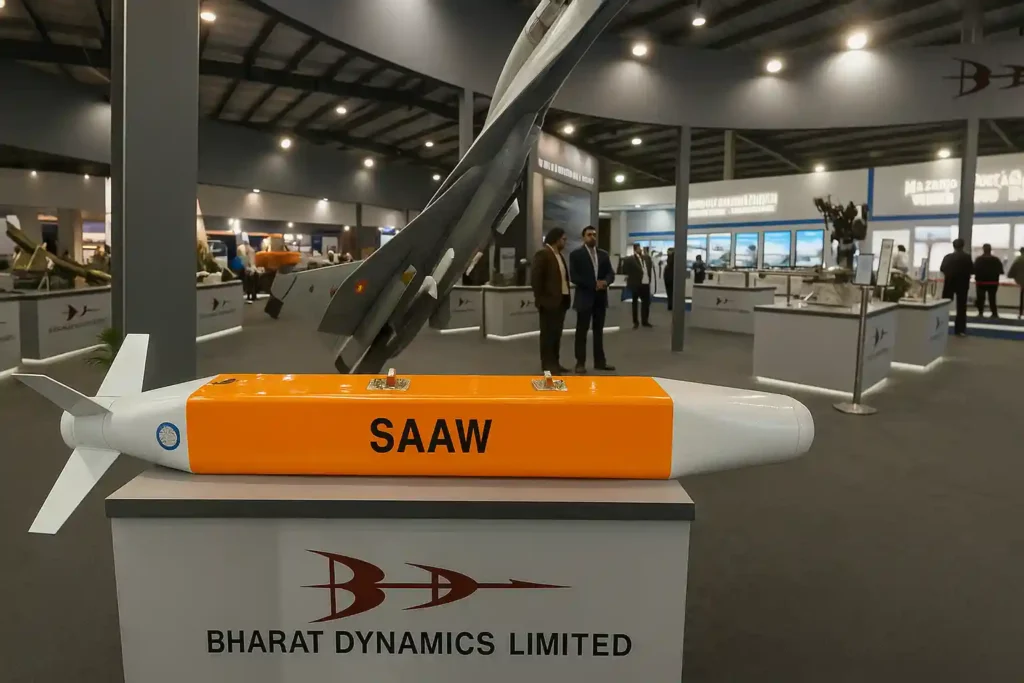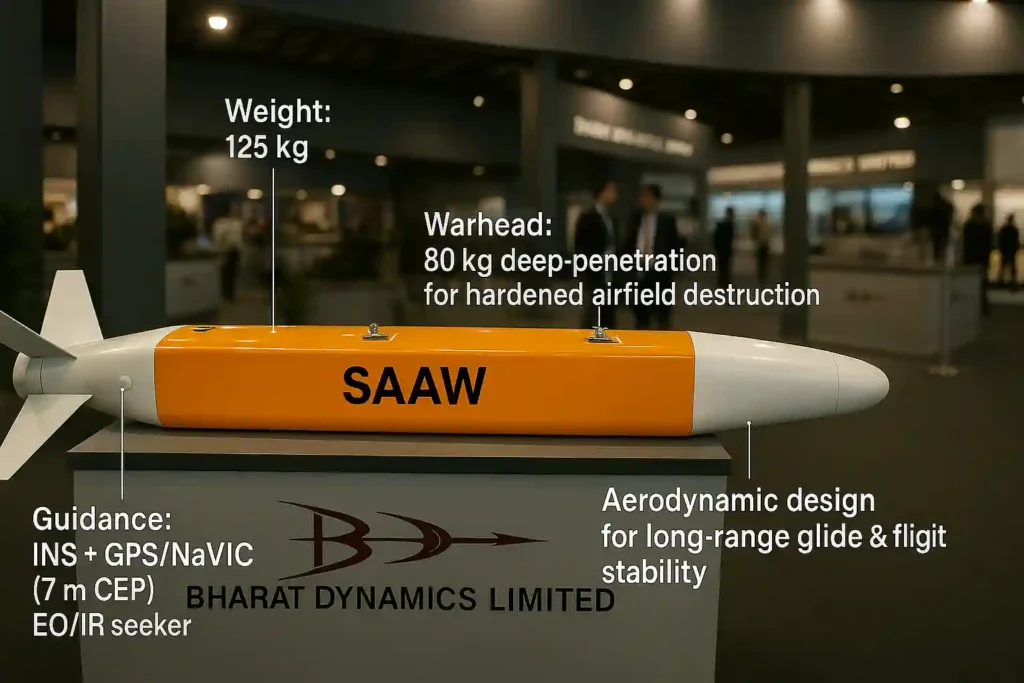India’s defence sector has achieved significant advancements, and the Smart Anti-Airfield Weapon (SAAW) stands out as a symbol of indigenous innovation. Developed by DRDO, this precision-guided glide bomb is designed to disable enemy airfield infrastructure without exposing pilots to risk.
At DefenceNewsIndia, we bring you in-depth, reliable insights on how this smart anti-airfield weapon is reshaping India’s strike capabilities.
Introduction to Smart Anti-Airfield Weapon

The Smart Anti-Airfield Weapon (SAAW) is a 125 kg class precision-guided glide bomb designed to help the Indian Air Force disable enemy airfields and critical infrastructure from a safe distance.
With a standoff range of 90 to 100 kilometres, this weapon enables Indian Air Force (IAF) aircraft to destroy enemy airfields, runways, bunkers, and fuel storage facilities while remaining outside hostile air defence zones. This cost-effective smart munition strengthens India’s air superiority doctrine.
Design and Technical Specifications

Weight, Warhead, and Build
- The Smart Anti-Airfield Weapon is 125 kg with an 80 kg warhead for airfield strikes.
- Its warhead is designed for deep penetration and to disable hardened airfield structures.
- Aerodynamic design ensures long-range glide and stability during flight.
Guidance Systems and Accuracy
- Combines an Inertial Navigation System (INS) with GPS/NavIC for mid-course guidance.
- The basic model achieves a CEP of 7 metres.
- EO/IR seeker variants offer sub-3 metre accuracy and work reliably even when GPS signals are blocked.
Platforms and Integration
The Smart Anti-Airfield Weapon works seamlessly with IAF’s Jaguar, Mirage 2000, MiG-29, Su-30MKI, Tejas, Hawk-i, and will soon be added to Rafale. The HAL CATS Warrior unmanned combat aerial vehicle will deploy SAAW in future high-risk missions. HAL’s upcoming stealth UCAVs and loyal wingman drones are also being considered for SAAW integration.
HAL CATS Warrior and UAV Integration
The CATS Warrior will enable SAAW deployment in dangerous missions without endangering pilots. This unmanned platform will extend SAAW’s reach deep into enemy territory. Integration with other UAVs, such as Ghatak UCAV, will further boost India’s unmanned precision strike capability.
Development History and Milestones
Key Stages
- 2013: DRDO approved SAAW under India’s smart munition initiative.
- 2016: First successful trials.
- 2018: Validation trials at Pokhran demonstrated accuracy.
- 2021: EO seeker tests confirmed sub-3 metre precision.
- 2025: Satellite-guided variant and advanced seeker trials underway.
Test Achievements
- Proven ability to disable runways and hardened targets.
- Demonstrated performance across various altitudes and launch profiles.
- Validated against simulated enemy airfield setups.
Operational Status and IAF Induction
Since 2021, SAAW has been inducted into IAF service, initially on Jaguars and Su-30MKIs. Mirage 2000 squadrons followed, and Rafale integration is in progress. The IAF plans to operationalise satellite-guided and EO/IR seeker variants by 2026, enhancing precision strike options.
Strategic Importance
Role in Military Doctrine
SAAW supports India’s airfield denial strategy by neutralising enemy air assets before take-off. Its standoff capability ensures pilot safety while enabling surprise attacks. The weapon’s affordability complements high-end missiles, offering scalable deployment during conflicts.
Comparison with Global Systems
SAAW outperforms older airfield attack bombs like the BLU-107 Durandal in both range and accuracy. It offers a cost-efficient alternative to imported precision-guided munitions, aligning with India’s self-reliance goals.
Detailed Comparison Points
Indigenous Support: SAAW benefits from local production, upgrades, and maintenance, ensuring operational availability and reducing dependency on foreign suppliers.
Range: SAAW delivers a standoff range of 90–100 km, while older systems like the BLU-107 Durandal have significantly shorter effective ranges, requiring aircraft to come closer to enemy air defences.
Accuracy: SAAW’s EO/IR seeker variants achieve sub-3 metre precision, whereas many legacy systems lack such advanced guidance and terminal accuracy.
Cost: SAAW provides similar or superior capabilities at a fraction of the cost of imported precision-guided bombs, making it highly economical for large-scale deployment.
Integration: Unlike imported munitions that may need complex integration efforts, SAAW is designed for seamless compatibility with Indian platforms, including Jaguars, Su-30MKIs, Mirage 2000s, and future UAVs.
Latest Developments (June 2025)
IAF and MoD Initiatives
The IAF is finalising the procurement of satellite-guided SAAW variants. The Ministry of Defence is reviewing proposals for the mass production of the upgraded models.
DRDO Enhancements
DRDO is testing seekers with improved moving target engagement and resistance to jamming, preparing SAAW for future battlefield challenges.
UAV Roadmap
The HAL CATS Warrior and other UAVs will soon conduct SAAW flight trials to validate deployment from unmanned platforms, setting the stage for next-gen combat operations.
Operational Advantages
- Survivability: Launch aircraft remain beyond the enemy air defence range.
- Cost-effectiveness: Lower cost than cruise missiles or imported PGMs.
- Platform versatility: Integrates with manned and unmanned systems.
- Mission flexibility: Suitable for runway denial, fuel depot destruction, and hardened bunker attacks.
Frequently Asked Questions
1. What is the range of the Smart Anti-Airfield Weapon?
SAAW offers a standoff range of 90 to 100 kilometres, ensuring safe and precise strikes.
2. Which aircraft and platforms can deploy SAAW?
SAAW is already in use or planned for Jaguars, Mirage 2000, MiG-29, Su-30MKI, Tejas, Hawk-i, Rafale, HAL CATS Warrior, and upcoming Indian drones.
3. Is SAAW operational with the IAF?
Yes, SAAW is operational across multiple IAF squadrons as of June 2025, with upgraded variants on the way.
4. How does SAAW compare to imported precision bombs?
SAAW provides similar or better precision at a fraction of the cost and ensures indigenous support and upgradeability.
Final Thoughts
The Smart Anti-Airfield Weapon represents a major leap in India’s precision strike capability. With its standoff range, advanced seekers, and integration with both manned and unmanned systems, SAAW will play a critical role in India’s future air operations. For detailed analysis and updates, visit DefenceNewsIndia.
